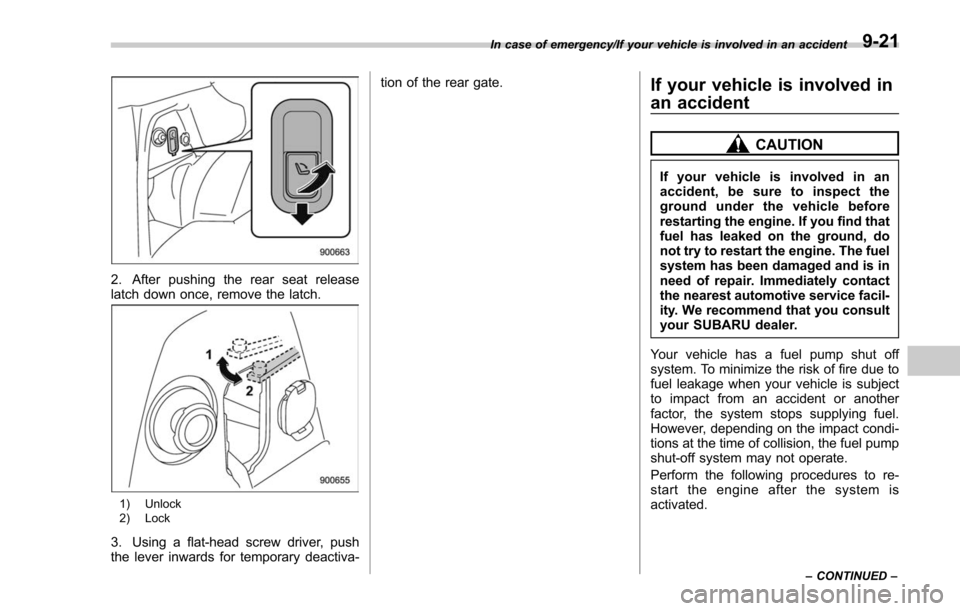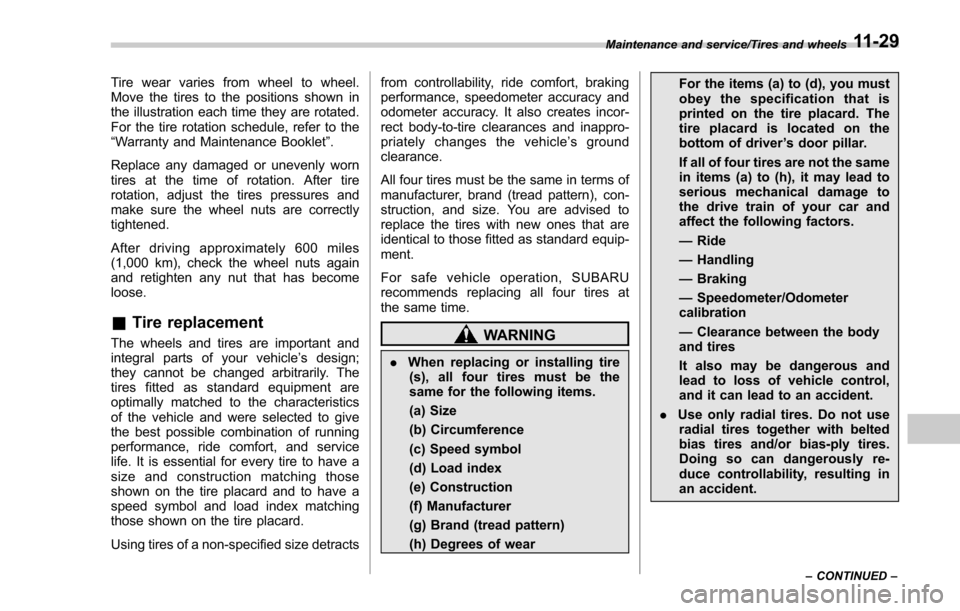2017 SUBARU FORESTER ground
[x] Cancel search: groundPage 516 of 634

Towing
If towing is necessary, it is best done by
your SUBARU dealer or a commercial
towing service. Observe the following
procedures for safety.
WARNING
Never tow AWD models (both CVT
and MT models) with the front
wheels raised off the ground while
the rear wheels are on the ground,
or with the rear wheels raised off the
ground while the front wheels are on
the ground. This will cause the
vehicle to spin away due to the
operation or deterioration of the
center differential.
&Towing and tie-down hooks
The towing hooks should be used only in
an emergency (e.g., to free a stuck vehicle
from mud, sand or snow).
CAUTION
. Use only the specified towing
hook and tie-down hook. Never
use suspension parts or other
parts of the body for towing or
tie-down purposes.
. To prevent deformation to the
front bumper and the towing
hook, do not apply excessive
lateral load to the towing hook. Front towing hook:
1. Take the towing hook, screwdriver and
jack handle out of the cargo area.
2. Cover the tip of a flat-head screwdriver
with vinyl tape or cloth so that it will not
scratch the bumper. Insert the flat-head
screwdriver into the cutout of the cover
and pry open the cover.
In case of emergency/Towing
–CONTINUED –9-13
Page 519 of 634

In case of emergency/Towing
position for CVT models. Shift the shift
lever into the“1st ”position for MT models.
2. Apply the parking brake firmly.
3. Secure the vehicle onto the carrier
properly with safety chains. Each safety
chain should be equally tightened and
care must be taken not to pull the chains
so tightly that the suspension bottoms out.
CAUTION
If your vehicle has a front under-
spoiler and rear underspoiler (both
optional), be careful not to scrape
them when placing the vehicle on
the carrier and when removing the
vehicle from the carrier.
& Towing with all wheels on the
ground
1. Release the parking brake and put the
transmission in the “N”/neutral position.
2. The ignition switch should be in the
“ON ”position while the vehicle is being
towed.
3. Take up slack in the towline slowly to
prevent damage to the vehicle.
WARNING
. Never turn the ignition switch to
the “LOCK ”/“OFF ”position while
the vehicle is being towed be-
cause the steering wheel and the
direction of the wheels will be
locked. .
Remember that the brake booster
and power steering do not func-
tion when the engine is not
running. Because the engine is
turned off, it will take greater
effort to operate the brake pedal
and steering wheel.
CAUTION
. If transmission failure occurs,
transport your vehicle on a flat-
bed truck.
. For CVT models, the traveling
speed must be limited to less
than 20 mph (30 km/h) and the
traveling distance to less than 31
miles (50 km). For greater speeds
and distances, transport your
vehicle on a flat-bed truck.
9-16
Page 524 of 634

2. After pushing the rear seat release
latch down once, remove the latch.
1) Unlock
2) Lock
3. Using a flat-head screw driver, push
the lever inwards for temporary deactiva-tion of the rear gate.
If your vehicle is involved in
an accident
CAUTION
If your vehicle is involved in an
accident, be sure to inspect the
ground under the vehicle before
restarting the engine. If you find that
fuel has leaked on the ground, do
not try to restart the engine. The fuel
system has been damaged and is in
need of repair. Immediately contact
the nearest automotive service facil-
ity. We recommend that you consult
your SUBARU dealer.
Your vehicle has a fuel pump shut off
system. To minimize the risk of fire due to
fuel leakage when your vehicle is subject
to impact from an accident or another
factor, the system stops supplying fuel.
However, depending on the impact condi-
tions at the time of collision, the fuel pump
shut-off system may not operate.
Perform the following procedures to re-
start the engine after the system is
activated.
In case of emergency/If your vehicle is involved in an accident
–CONTINUED –9-21
Page 560 of 634

Tire wear varies from wheel to wheel.
Move the tires to the positions shown in
the illustration each time they are rotated.
For the tire rotation schedule, refer to the
“Warranty and Maintenance Booklet”.
Replace any damaged or unevenly worn
tires at the time of rotation. After tire
rotation, adjust the tires pressures and
make sure the wheel nuts are correctly
tightened.
After driving approximately 600 miles
(1,000 km), check the wheel nuts again
and retighten any nut that has become
loose.
& Tire replacement
The wheels and tires are important and
integral parts of your vehicle’ s design;
they cannot be changed arbitrarily. The
tires fitted as standard equipment are
optimally matched to the characteristics
of the vehicle and were selected to give
the best possible combination of running
performance, ride comfort, and service
life. It is essential for every tire to have a
size and construction matching those
shown on the tire placard and to have a
speed symbol and load index matching
those shown on the tire placard.
Using tires of a non-specified size detracts from controllability, ride comfort, braking
performance, speedometer accuracy and
odometer accuracy. It also creates incor-
rect body-to-tire clearances and inappro-
priately changes the vehicle
’s ground
clearance.
All four tires must be the same in terms of
manufacturer, brand (tread pattern), con-
struction, and size. You are advised to
replace the tires with new ones that are
identical to those fitted as standard equip-
ment.
For safe vehicle operation, SUBARU
recommends replacing all four tires at
the same time.WARNING
. When replacing or installing tire
(s), all four tires must be the
same for the following items.
(a) Size
(b) Circumference
(c) Speed symbol
(d) Load index
(e) Construction
(f) Manufacturer
(g) Brand (tread pattern)
(h) Degrees of wear For the items (a) to (d), you must
obey the specification that is
printed on the tire placard. The
tire placard is located on the
bottom of driver
’s door pillar.
If all of four tires are not the same
in items (a) to (h), it may lead to
serious mechanical damage to
the drive train of your car and
affect the following factors.
— Ride
— Handling
— Braking
— Speedometer/Odometer
calibration
— Clearance between the body
and tires
It also may be dangerous and
lead to loss of vehicle control,
and it can lead to an accident.
. Use only radial tires. Do not use
radial tires together with belted
bias tires and/or bias-ply tires.
Doing so can dangerously re-
duce controllability, resulting in
an accident.
Maintenance and service/Tires and wheels
–CONTINUED –11-29
Page 581 of 634

Specifications/Specifications
Specifications
These specifications are subject to change without notice.
&Dimensions
in (mm)
Item Non-turbo models Turbo models
Overall length 181.5 (4,610) 180.9 (4,595)
Overall width 70.7 (1,795)
Overall height 68.3 (1,735)*
2
67.7 (1,720)*3
Wheel base 103.9 (2,640)
Tread Front 60.8 (1,545)
Rear 61.2 (1,555)
Ground clearance*
18.7 (220)
*1: Measured with vehicle empty
*2: Models with roof rails
*3: Models without roof rails
12-2
Page 626 of 634

Tires and wheels....................................................... 11-23
Tools ........................................................................\
.. 9-3
Top tether anchorages ........................................ 1-37, 1-40
Towing ...................................................................... 9-13
All wheels on the ground ........................................ 9-16
Flat-bed truck ........................................................ 9-15
Hooks ................................................................... 9-13
Weight.................................................................. 8-19
Trailer
Connecting ............................................................ 8-17
Hitch ............................................................ 8-16, 8-22
Towing .................................................................. 8-19
Towing tips ............................................................ 8-23
Trip meter ................................................................. 3-10
Turn signal Indicator lights ....................................................... 3-32
Lever .................................................................. 3-100
U
Under-floor storage compartment ................................. 6-17
V
Valet mode ................................................................ 2-29
Vanity mirror .......................................................... 6-5, 6-5
Vehicle Capacity weight ..................................................... 8-13
Identification ........................................................ 12-19
Symbols .................................................................... 3
Vehicle Dynamics Control OFF indicator light .................................................. 3-25
OFF switch ........................................................... 7-41 Operation indicator light
........................................... 3-25
System .................................................................. 7-39
Warning light .......................................................... 3-24
Ventilator .................................................................... 4-2
Voice command system operation ... ............................. 5-80
W
Warning and indicator lights ......................................... 3-13
Warning chimes Keyless access with push-button start system .... ........ 3-25
Seatbelt. ................................................................ 3-14
Warning light ABS...................................................................... 3-21
Access key ............................................................ 3-25
All-Wheel Drive ...................................................... 3-23
AT OIL TEMP ......................................................... 3-19
Automatic headlight beam leveler ............................. 3-32
Brake system ......................................................... 3-21
Charge .................................................................. 3-18
CHECK ENGINE .................................................... 3-16
Coolant temperature high ........................................ 3-17
Door open ............................................................. 3-23
Engine low oil level ................................................. 3-18
Hill start assist ....................................................... 3-23
Keyless access with push-button start system .... ........ 3-25
Low fuel ................................................................ 3-22
Low tire pressure .................................................... 3-19
Oil pressure ........................................................... 3-18
Power steering .......................................................
3-23
Seatbelt. ................................................................ 3-14
SRS airbag system ................................................. 3-15
Index14-11